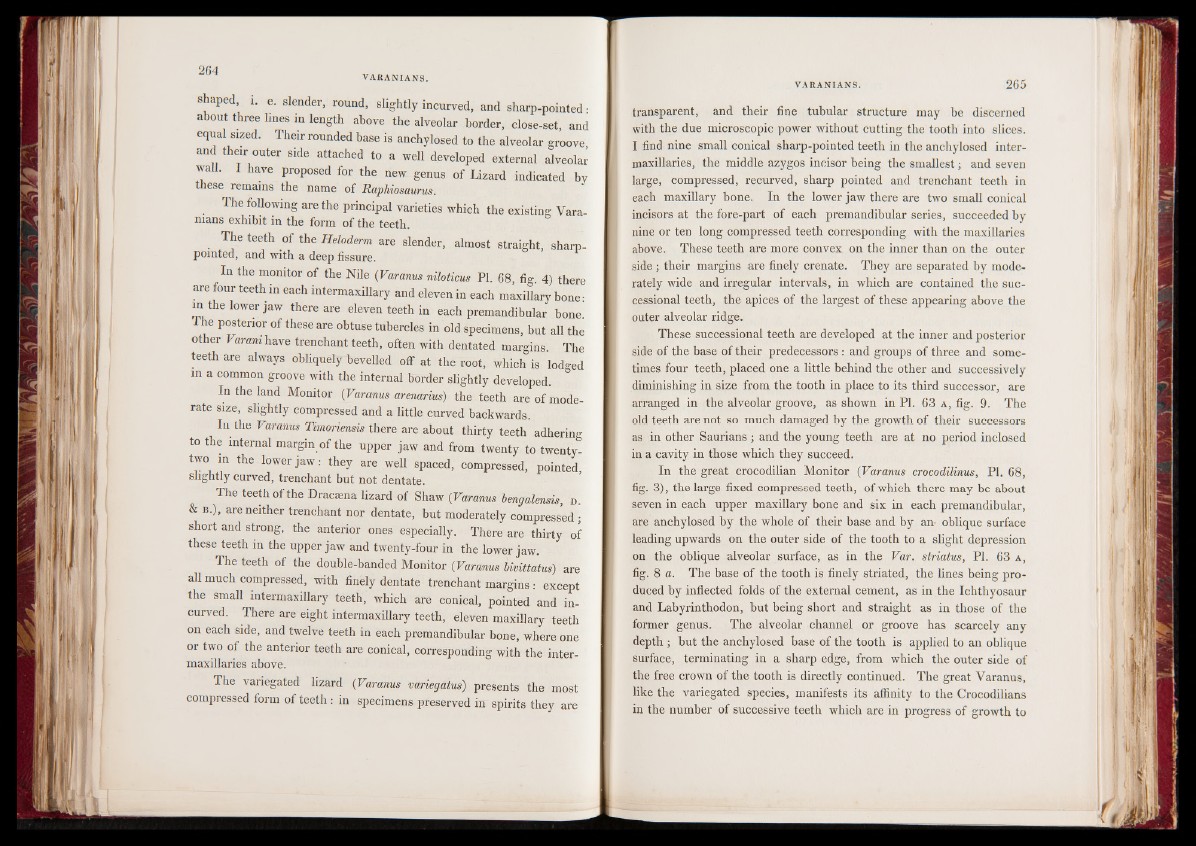
VARANIANS.
shaped, « e. slender, round, slightly incurved, and sharp-pointed •
about three hues in length above the alveolar border, close-set, and
equal sized. Their rounded base is anchylosed to the alveolar groove
and their outer side attached to a well developed external alveolar
wall. I have proposed for the new genus of Lizard indicated by
these remains the name of Raphiosaurus.
The following are the principal varieties which the existing Vara-
nians exhibit in the form of the teeth.
The teeth of the Heloderm are slender, almost straight, sharp-
pointed, and with a deep fissure.
In the monitor of the Nile (Varams niloticus PI. 68, fig. 4) there
are four teeth in each intermaxillary and eleven in each maxillary bone:
m the lower jaw there are eleven teeth in each premandibular bone.
I he posterior of these are obtuse tubercles in old specimens, but all the
other Varani have trenchant teeth, often with dentated margins. The
teeth are always obliquely bevelled off at the root, which is lodged
in a common groove with the internal border slightly developed.
In the land Monitor (Varams arenarius). the teeth are of moderate
size, slightly compressed and a little curved backwards.
In the Varanus Tmoriensis there are about thirty teeth adhering
to the internal margin of the upper jaw and from twenty to twenty-
two in the lower jaw: they are well spaced, compressed, pointed
slightly curved, trenchant but not dentate.
The teeth of the Dracaena lizard of Shaw (Varanus bengalensis, d .
& b .), are neither trenchant nor dentate, but moderately compressed ;
short and strong, the anterior ones especially. There are thirty of
these teeth in the upper jaw and twenty-four in the lower jaw.
The teeth of the double-banded Monitor (Varanus Uvittatus) are
all much compressed, with finely dentate trenchant margins: except
the small intermaxillary teeth, which are conical, pointed and incurved.
There are eight intermaxillary teeth, eleven maxillary teeth
on each side, and twelve teeth in each premandibular bone, where one
or two of the anterior teeth are conical, corresponding with the inter-
maxillaries above.
The variegated lizard (Varanus variegatus) presents the most
compressed form of teeth: in specimens preserved in spirits they are
transparent, and their fine tubular structure may be discerned
with the due microscopic power without cutting the tooth into slices.
I find nine small conical sharp-pointed teeth in the anchylosed inter-
maxillaries, the middle azygos incisor being the smallest; and seven
large, compressed, recurved, sharp pointed and trenchant teeth in
each maxillary bone. In the lower jaw there are two small conical
incisors at the fore-part of each premandibular series, succeeded by
nine or ten long compressed teeth corresponding with the maxillaries
above. These teeth are more convex on the inner than on the outer
side ; their margins are finely crenate. They are separated by moderately
wide and irregular intervals, in which are contained the suc-
cessional teeth, the apices of the largest of these appearing above the
outer alveolar ridge.
These successional teeth are developed at the inner and posterior
side of the base of their predecessors : and groups of three and sometimes
four teeth, placed one a little behind the other and successively
diminishing in size from the tooth in place to its third successor, are
arranged in the alveolar groove, as shown in PI. 63 a , fig. 9. The
old teeth are not so much damaged by the growth of their successors
as in other Saurians ; and the young teeth are at no period inclosed
in a cavity in those which they succeed.
In the great crocodilian Monitor (Varanus crocodilinus, PI. 68,
fig. 3), the large fixed compressed teeth, of which there may be about
seven in each upper maxillary bone and six in each premandibular,
are anchylosed by the whole of their base and by an- oblique surface
leading upwards on the outer side of the tooth to a slight depression
on the oblique alveolar surface, as in the Var. striatus, PI. 63 a ,
fig. 8 a. The base of the tooth is finely striated, the lines being produced
by inflected folds of the external cement, as in the Ichthyosaur
and Labyrinthodon, but being short and straight as in those of the
former genus. The alveolar channel or groove has scarcely any
depth ; but the anchylosed base of the tooth is applied to an oblique
surface, terminating in a sharp edge, from which the outer side of
the free crown of the tooth is directly continued. The great Varanus,
like the variegated species, manifests its affinity to the Crocodilians
in the number of successive teeth which are in progress of growth to